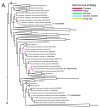Molecular Phylogenomics Reveals the Deep Evolutionary History of Carnivory across Land Plants
- PMID: 37836100
- PMCID: PMC10574757
- DOI: 10.3390/plants12193356
Molecular Phylogenomics Reveals the Deep Evolutionary History of Carnivory across Land Plants
Abstract
Plastid molecular phylogenies that broadly sampled angiosperm lineages imply that carnivorous plants evolved at least 11 times independently in 13 families and 6 orders. Within and between these clades, the different prey capture strategies involving flypaper and pitfall structures arose in parallel with the subsequent evolution of snap traps and suction bladders. Attempts to discern the deep ontological history of carnivorous structures using multigene phylogenies have provided a plastid-level picture of sister relationships at the family level. Here, we present a molecular phylogeny of the angiosperms based on nuclear target sequence capture data (Angiosperms-353 probe set), assembled by the Kew Plant Trees of Life initiative, which aims to complete the tree of life for plants. This phylogeny encompasses all carnivorous and protocarnivorous families, although certain genera such as Philcoxia (Plantaginaceae) are excluded. This study offers a novel nuclear gene-based overview of relationships within and between carnivorous families and genera. Consistent with previous broadly sampled studies, we found that most carnivorous families are not affiliated with any single family. Instead, they emerge as sister groups to large clades comprising multiple non-carnivorous families. Additionally, we explore recent genomic studies across various carnivorous clades that examine the evolution of the carnivorous syndrome in relation to whole-genome duplication, subgenome dominance, small-scale gene duplication, and convergent evolution. Furthermore, we discuss insights into genome size evolution through the lens of carnivorous plant genomes.
Keywords: Alismatales; Caryophyllales; Ericales; Lamiales; Oxidales; Phylogenomics; Poales; genomics.
Conflict of interest statement
The authors declare no conflict of interest.
Figures



References
-
- Givnish T.J., Burkhardt E.L., Happel R.E., Weintraub J.D. Carnivory in the bromeliad Brocchinia reducta, with a cost/benefit model for the general restriction of carnivorous plants to sunny, moist, nutrient-poor habitats. Am. Nat. 1984;124:479–497. doi: 10.1086/284289. - DOI
-
- Givnish T.J., Sytsma K., Smith J., Hahn W., Benzing D., Burkhardt E. Molecular evolution and adaptive radiation n Brocchinia (Bromeliaceae: Pitcairnioideae) atop tepuis of the Guayana Shield. In: Givnish T.J., Sytsma K.J., editors. Molecular Evolution and Adaptive Radiation. Cambridge University Press; New York, NY, USA: 1997. pp. 259–311.
-
- Givnish T.J. Ecology and evolution of carnivorous plants. In: Abrahamson W.G., editor. Plant-Animal Interactions. McGraw-Hill; New York, NY, USA: 1989. pp. 243–290.
Publication types
LinkOut - more resources
Full Text Sources

